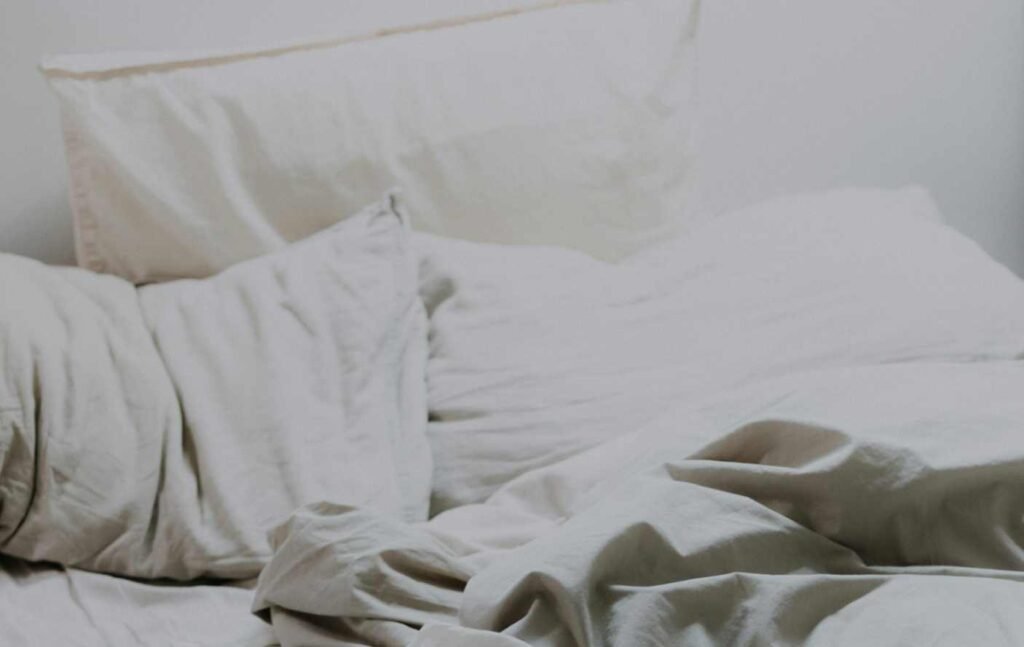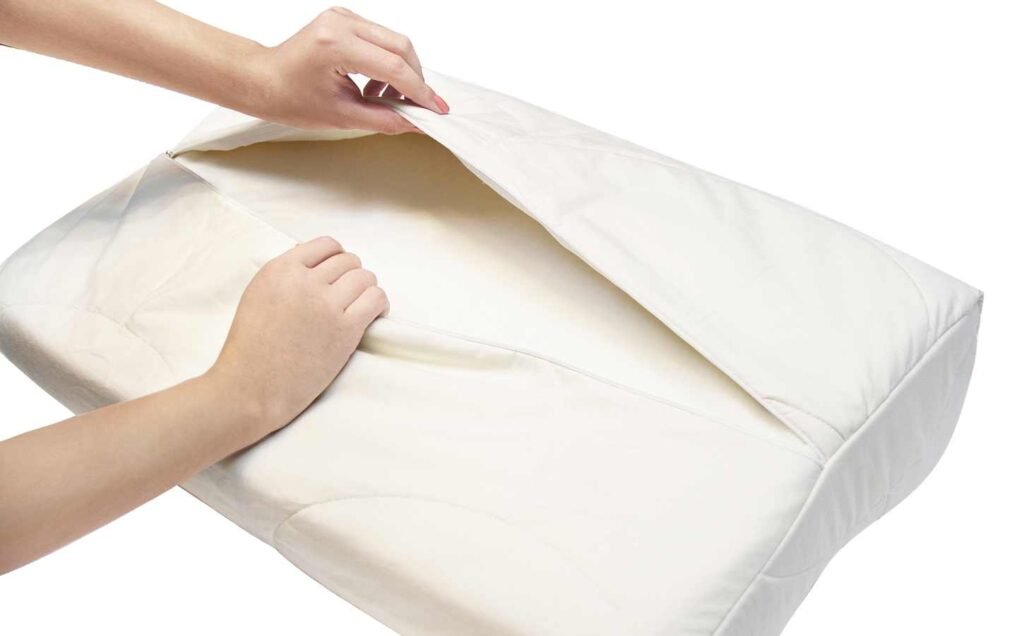It’s often said that we spend about one third of our lifetime in bed, yet how frequently do we consider how to sanitize pillows?
This crucial aspect of bedroom hygiene is commonly overlooked, even though it plays a significant role in our overall health and well-being. While we may regularly change sheets and launder other bedding, attention to pillow sanitation is often forgotten.
I think this is because most people consider that changing and/or washing the pillow case is enough to protect the pillow inside. However, this is not the case – pardon any pun perceived – and we were never taught how to sanitize pillows growing up.
This guide aims to shed light on simple yet effective methods on how to sanitize pillows to keep them clean and fresh, ensuring that the considerable time you spend resting is as beneficial as possible. We have also included useful products available on Amazon to help you in this task.
Pillows are a breeding ground for dust mites, bacteria, and allergens, which can affect your health and sleep quality. Regularly sanitizing your pillows ensures they remain clean, fresh, and conducive to a good night’s rest.
Step 1: Choose the Right Cleaning Materials
Before you start the cleaning process, it’s important to select the right cleaning agents. Opt for a gentle, hypoallergenic detergent that effectively removes dirt without damaging the pillow fabric. For feather or down pillows, a detergent such as Woolite Delicates Hypoallergenic Liquid Laundry Detergent, available on Amazon, is a perfect choice as it is designed to clean gently.
As an Amazon.com Affiliate, we may earn a small commission if you buy from a link within this page.
Step 2: Wash Your Pillows
Most pillows, including those filled with cotton, feather, down, and synthetic fibers, can be washed in a washing machine. However, always check the care label first. Use warm water and a gentle cycle. For best results, wash two pillows at a time to keep the machine balanced. Add an extra rinse cycle to ensure all detergent is washed out.
Step 3: Dry Your Pillows Properly
After washing, pillows need to be thoroughly dried to prevent mold and mildew growth. For feather and down pillows, use a low heat setting on your dryer and add a couple of dryer balls to help fluff the pillows as they dry. The Smart Design Sneaker Dryer & Wash Bag Wool Dryer Balls by Smart Sheep can be found on Amazon and are ideal for this purpose.
Step 4: Spot Clean and Deodorize
For stains or odors that survive the wash, spot cleaning might be necessary. Use a stain remover safe for fabrics, like Grandma’s Secret Spot Remover, available on Amazon. To deodorize, sprinkle the pillow with baking soda, let it sit for an hour, and then vacuum it up using an upholstery attachment.
Step 5: Use Pillow Protectors
To extend the cleanliness and life of your pillows, use pillow protectors. They not only keep dirt and oils at bay but also make regular cleaning easier. Look for hypoallergenic and breathable options on Amazon, like the AllerEase Maximum Allergy Protection Pillow Protectors.
Conclusion:
Regularly sanitizing your pillows is crucial for maintaining a clean and healthy sleeping environment. By following these steps and using the recommended products from Amazon, you can ensure your pillows remain in excellent condition, helping you achieve a restful night’s sleep.
Advertisement:
- ❤❤Wide Application ❤❤: UV light sanitizer suitable for home, office, business trip, travel, car. The UV wand protects form all aspects of our life.
- ❤❤ Rechargeable❤❤ : UV light sanitizer with USB rechargeable cable ,only needs to be charged for one hour and can be used for five hours, which is more convenient to us .
- ❤❤ Easy to Use ❤❤: This UV sterilizer charges in just one hour and provides up to five hours of use, making it super convenient. Simply turn it on, and it’s ready to go !
- ❤❤Portable ❤❤: UV light sanitizer is mini size and lightweight.Size: 37.5*4*3.5CM ; 0.22kg. It’s easy to carry and put in your handbag, whether at home or on a trip. No matter where you go, you can make sure that you live in a clean environment.
- ❤❤ Warming Tips❤❤: Please don’t use this UV light sanitizer on human body, pets, plants. Don’t direct your eyes.
Understanding Different Pillow Materials
Pillows come in various materials, each requiring specific care to maintain their quality and effectiveness:
- Memory Foam: Avoid machine washing as it can break down the foam. Spot clean stains with a mild detergent and allow to air dry completely. Use a pillowcase to protect it from oils and sweat.
- Latex: Like memory foam, latex pillows should not be machine washed. Wipe with a damp cloth and a mild detergent for cleaning. Ensure it is thoroughly dried in a well-ventilated area.
- Down and Feather: These pillows can usually be machine washed on a gentle cycle. Use a small amount of mild detergent and dry on low heat with dryer balls to help fluff the feathers back up.
- Synthetic (polyester, microfiber): These are generally more durable and can be washed in a machine with warm water and dried on a medium-heat setting.
Understanding the material-specific care requirements ensures your pillows not only get clean but also last longer.
Frequency of Pillow Cleaning
The frequency of cleaning your pillows can depend on several factors:
- General guideline: Wash your pillows at least every three to six months to keep them fresh and clean.
- Allergy sufferers: Consider washing pillows every two to four weeks to reduce allergens.
- Pet owners: If pets sleep on your bed, monthly cleaning might be necessary to remove pet hair and dander.
- High humidity areas: More frequent washing can prevent mold and mildew buildup due to moisture.
Sticking to a regular cleaning schedule can significantly improve your sleep health and pillow longevity.

Health Benefits of Clean Pillows
Regularly sanitized pillows contribute to better health:
- Allergy Relief: Reduces exposure to allergens like dust mites and pet dander, which can trigger allergies and asthma.
- Skin Health: Keeps acne-causing oils and bacteria away from your face as you sleep.
- Respiratory Health: Minimizes the risk of breathing in mold, fungus, and bacteria, promoting better respiratory health.
Keeping your pillows clean supports not just better sleep but also overall health.
Natural Cleaning Solutions
For those preferring environmentally friendly options, here are some natural cleaning solutions:
- Vinegar and Baking Soda: Great for removing stains and odors. Apply a paste of baking soda and water to the stain, let sit, then dab away with a cloth soaked in a vinegar-water solution.
- Essential Oils: Add a few drops of lavender or tea tree oil to the wash for their natural antibacterial properties and calming scents.
- Lemon Juice: Acts as a natural bleach for lighter fabrics and can help remove tough stains and brighten whites.
These natural alternatives are not only safe for most pillow types but also for the environment.
Professional Cleaning Tips
Professional cleaners often recommend:
- Thorough Drying: Ensure pillows are completely dry before using them again to prevent mold growth.
- Spot Treatment: For tough stains, apply a small amount of detergent directly to the area and gently rub in before washing.
- Non-chemical Deodorizers: Frequent airing out of pillows can reduce the need for washing and extend their freshness.
Gleaning tips from professionals can make home pillow care much more effective.
Troubleshooting Common Issues
Common issues and solutions when sanitizing pillows include:
- Lingering Smells: If odors persist, sprinkle baking soda on the pillow, leave for a few hours, then vacuum it up.
- Dampness: Ensure pillows are dried in a sunny spot or a well-ventilated area. Consider using multiple cycles in the dryer at a low heat setting.
Addressing these common problems helps maintain your pillows in optimal condition.
Sustainable Practices
When it’s time to replace old pillows:
- Disposal: Donate usable pillows to animal shelters or homeless shelters. Check if local textile recycling facilities accept old pillows.
- Purchasing: Opt for pillows made from sustainable materials like organic cotton or bamboo fibers.
Implementing sustainable practices in pillow care ensures environmental responsibility while maintaining health and comfort.
Products mentioned in this article include:
Woolite Delicates Hypoallergenic Liquid Laundry Detergent
Smart Design Sneaker Dryer & Wash Bag Wool Dryer Balls by Smart Sheep
AllerEase Maximum Allergy Protection Pillow Protectors.
Each of these links are affiliate links, which means we may earn a small commission should you buy after clicking on one, or more of those links. At no extra cost to you.
How to Clean a Memory Foam Pillow: A Step-by-Step Guide

Memory foam pillows, known for their support and comfort, require specific care to maintain their integrity and hygiene. This guide will walk you through the essential steps on how to clean a memory foam pillow, ensuring it remains a hygienic and comforting part of your sleep routine.
Continue reading: How to Clean a Memory Foam Pillow




